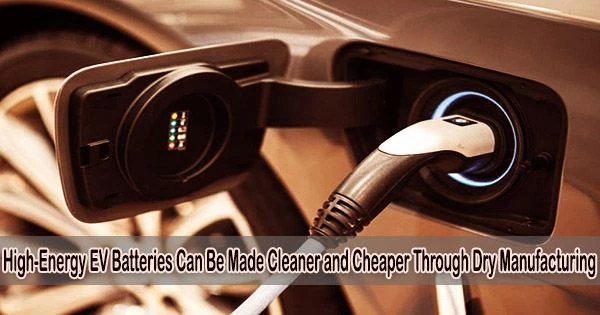A clean energy economy depends on lithium-ion batteries, which are used to power electric cars. However, they frequently use an expensive manufacturing method that poses dangers to human health and the environment while producing their electrodes: a wet slurry with toxic solvents.
A dry battery production technique offers a number of advantages, according to preliminary research conducted at the Oak Ridge National Laboratory of the Department of Energy. The solvent is eliminated, and it appears that the battery will be strong, less burdened down by inactive components, and able to maintain a high energy storage capacity after usage. These advancements might encourage EV use on a larger scale, lowering carbon emissions and advancing American climate goals.
Although dry processing is a relatively new alternative that reduces startup costs, time, energy, waste disposal, and factory floor space, researchers have only recently begun to fully understand how and why it operates.
ORNL and its business partner Navitas Systems investigated how the dry process changed the electrochemical and structural characteristics of battery materials. As lithium ions move between electrodes known as the cathode and anode, batteries produce energy.
The team concentrated on an electrode dry processing method, which calls for combining dry powders with a binder before compacting the mixture to enhance particle interaction. By concentrating on particular components or mixing techniques, this approach might be used for both the cathode and the anode.
After Navitas made the electrodes, ORNL researchers led by Jianlin Li and Runming Tao measured their electrochemical performance in different conditions over various time frames. The ORNL team was able to reach a new understanding of how the dry-processed electrodes degrade.
A main goal for this project is to develop or identify a better binder for the dry process, because the current binder is not very stable for the anode environment.
Jianlin Li
According to findings published in Chemical Engineering Journal, the dry process batteries demonstrated a “superb” capacity preservation ability even after prolonged use. They are “highly chemically desirable” due to the fact that they have a structure that enables lithium ions to travel more directly between the anode and cathode. The electrodes are thicker in order to reduce inactive chemicals that increase bulk and weight and enable higher energy loading.
“There are more active materials in the electrode,” Tao said. “And even after cycling, it will have few cracks.”
These two advantages reflect a high energy density and good long-term cyclability. The electrode exhibits good mechanical strength and the winding capacity required for the mass manufacture of batteries by being able to bend and flex well.
Manufacturers and the American supply chain may benefit from the dry process in a number of ways, including: Battery plants are more suited in more locations thanks to their high compatibility with modern, state-of-the-art equipment for making electrodes.
“When you’re looking at the gigascale factories, you’re looking at billions of dollars in order to scale batteries up,” said Bryan Steinhoff, technical lead and lead researcher on the project for Navitas. “Dry processing can eliminate the coating and solvent equipment currently necessary for large-scale battery production. If you can use a dry process instead, you can reduce your footprint by up to 40 or 50%, saving hundreds of millions of dollars and starting to enable the creation of an infrastructure to replace one that is largely dependent on Asia at the moment.”
The process of stabilizing the substance that connects the anode components to a thin metal current collector is the next phase in the research.
“A main goal for this project is to develop or identify a better binder for the dry process, because the current binder is not very stable for the anode environment,” Li said. The team is also working on reducing the amount of carbon black, a material that maintains battery conductivity but detracts from its energy density.
ORNL and Navitas researchers continue to refine the process to improve electrochemical performance. The thicker electrode has the potential for larger energy loading and is simple to roll, but it may produce less power since the ions have a longer distance to travel. The objective is to strike a compromise between these advantages and disadvantages.
The research was sponsored by the DOE Advanced Materials and Manufacturing Technologies Office and conducted at DOE’s Battery Manufacturing Facility, the country’s largest open-access battery research and development center. Some material characterization was conducted at ORNL’s Center for Nanophase Materials Sciences, a DOE Office of Science user facility.
















